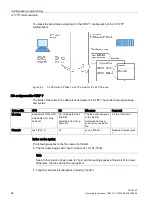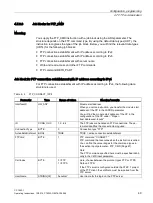
Configuration, programming
4.2 Restricting communications services in the CPU
CP 1543-1
34
Operating Instructions, 12/2019, C79000-G8976-C289-08
Protocol /
function
Port number (pro-
tocol)
Default of the port Port status
Authentication
Online security
diagnostics
8448 (TCP)
Closed
Open after configuration
No
HTTP
80 (TCP)
Closed
Open after configuration
No
HTTPS
443 (TCP)
Closed
Open after configuration
Yes
FTP
20 (TCP)
21 (TCP)
Closed
Open after configuration
No
FTPS
989 (TCP)
990 (TCP)
Closed
Open after configuration
Yes
SNMP
161 (UDP)
Open
Open after configuration
Yes (with SNMPv3)
* For information on avoiding opening port 102 during diagnostics, see section Online
security diagnostics via port 8448 (Page 68).
Ports of communication partners and routers
Make sure that you enable the required client ports in the corresponding firewall on the
communications partners and in intermediary routers.
These can be:
●
DHCP / 67, 68 (UDP)
●
DNS / 53 (UDP)
●
NTP / 123 (UDP)
●
SMTP / 25 (TCP) - Open in CP on block call (outgoing only)
●
SMTPS / 587 (TCP) - Open in CP on block call (outgoing only)
4.2
Restricting communications services in the CPU
Communications services without connections
The CPU can be a server for a series of communications services without connections being
configured for the CPU. Other communications partners can access CPU data. This means
that it is no longer possible for the local CPU to control communication with the clients.
The reliability of these communications services is set by the "Connection mechanisms"
parameter in the "Protection & Security" parameter group of the CPU.
















































